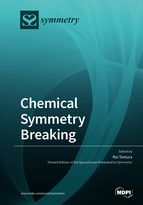Chemical Symmetry Breaking
A special issue of Symmetry (ISSN 2073-8994). This special issue belongs to the section "Chemistry: Symmetry/Asymmetry".
Deadline for manuscript submissions: closed (31 October 2020) | Viewed by 42704
Special Issue Editor
Interests: complexity phenomena; chiral symmetry breaking; spin symmetry breaking; chiral resolution; liquid crystals; organic crystals; magnetism
Special Issues, Collections and Topics in MDPI journals
Special Issue Information
Dear colleagues,
The ‘complexity theory’, which has developed rapidly since the 1970s, is regarded as one of the paradigm shifts or epoch-making revolutions of natural science in the twentieth century, together with the birth and establishment of ‘quantum mechanics’ and ‘Einsteinian general theory of relativity’ at the beginning of the same century. Today, a concept of the nonlinear complexity theory is recognized to govern a variety of dynamic behaviors observed in both natural and social sciences. In the ‘non-equilibrium (or out-of-equilibrium) complexity system’, symmetry-breaking occurs easily in concert with a phase transition of a chaotic or dissipative state to another one. In other words, fluctuation in a non-equilibrium state induces a phase transition to trigger the symmetry-breaking, and eventually, the nonlinear amplification of fluctuation leads to dissymmetric circumstances. A typical example is the birth of the universe by the cosmic inflation followed by big bang starting from a quantum fluctuation. Other familiar and important examples include many-body interactions of multiple elements responsible for the nonlinearity. Intermolecular interactions can give non-equilibrium objects, such as cells, bubbles, and metastable crystals, which may have strong links to the origin of the selected chirality of life. Thus, symmetry-breaking has been playing a primordial role in physics, chemistry and life science.
This Special Issue is devoted to investigations on the various chemical phenomena which originate from the symmetry-breaking induced by a phase transition in the condensed phases, such as metastable crystals, liquid crystals, amorphous solids, and polymer materials under non-equilibrium conditions, including other mysterious or strange chemical phenomena, which need elucidation of their mechanism in the near future, and theoretical calculations, such as determination of anisotropic organic crystal structures by computer simulations using various algorithm, etc.
You are cordially invited to contribute a short or long review article or full paper on such subjects to this Special Issue. We are particularly excited about the potential for the collected manuscripts to be further published in a book entitled “Chemical Symmetry Breaking” from MDPI.
Prof. Dr. Rui Tamura
Guest Editor
Manuscript Submission Information
Manuscripts should be submitted online at www.mdpi.com by registering and logging in to this website. Once you are registered, click here to go to the submission form. Manuscripts can be submitted until the deadline. All submissions that pass pre-check are peer-reviewed. Accepted papers will be published continuously in the journal (as soon as accepted) and will be listed together on the special issue website. Research articles, review articles as well as short communications are invited. For planned papers, a title and short abstract (about 100 words) can be sent to the Editorial Office for announcement on this website.
Submitted manuscripts should not have been published previously, nor be under consideration for publication elsewhere (except conference proceedings papers). All manuscripts are thoroughly refereed through a single-blind peer-review process. A guide for authors and other relevant information for submission of manuscripts is available on the Instructions for Authors page. Symmetry is an international peer-reviewed open access monthly journal published by MDPI.
Please visit the Instructions for Authors page before submitting a manuscript. The Article Processing Charge (APC) for publication in this open access journal is 2400 CHF (Swiss Francs). Submitted papers should be well formatted and use good English. Authors may use MDPI's English editing service prior to publication or during author revisions.
Keywords
- Polymorphic transition of an achiral crystal to a chiral one and vice versa
- Hydration/dehydration polymorphic transition mechanism in organic crystals
- Photoinduced mechanical motion of photochromic organic crystals
- Mechanochromism of organometallic crystals
- Chirality control of circularly polarized light (CPL) by cocrystals
- Chirality control of the helical structure of polymers
- Chiral discrimination in the conglomerate crystals
- Chiral resolution of racemic mixed crystals by simple recrystallization
- Chiral resolution and absolute asymmetric synthesis using crystallization of achiral molecules
- Crystal structure determination by direct space approach
- Chiral symmetry-breaking in liquids and liquid crystals
- Superparamagnetic behavior observed in magnetic organic nanocrystals and liquid crystals






